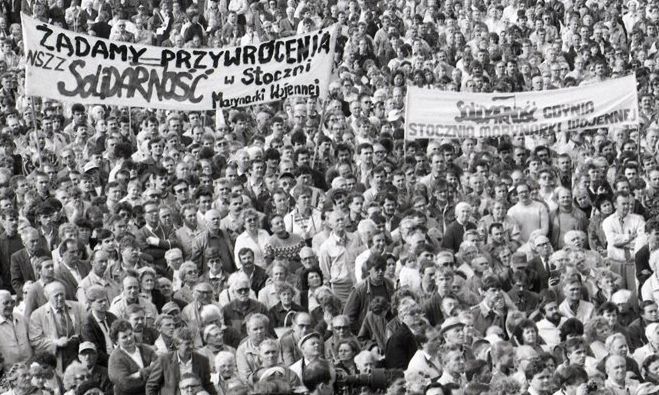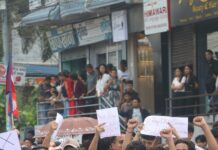A sharp debate in the 1990s led to the departure of a minority who could not recognise or understand epoch-making changes
This is a speech delivered by Vincent Kolo of chinaworker.info at a session of the 2024 Marxist School of ISA in China-Hong Kong-Taiwan devoted to the 50th anniversary of the founding of ISA/CWI. Other speakers at the session were Arne Johansson of the Swedish section (Socialistiskt Alternativ) and Kshama Sawant of the US section (Socialist Alternative).
The task of Marxists is not to simply learn and repeat formulas.
Basing ourselves on the method of Marxism we develop perspectives as a guide to action. When the CWI was formed in 1974, Stalinist bureaucratic regimes ruled one-third of the world, from North Korea to East Germany to Cuba. The USSR was the world’s second biggest economy after the US, and the number one military power.
The Stalinist dictatorships were grotesque caricatures of ‘socialism’. But the existence of planned economies, even bureaucratically distorted ones, and the formation of many new Stalinist regimes after 1945, had fundamentally altered the balance of world relations. These regimes were not interested in nor capable of leading a struggle against capitalism, but their existence served as a counterweight to capitalism. Key parts of the world economy – including Russia and China – were “off limits” to the capitalists. In a very distorted form this represented the power of the working class versus the capitalist class.
The collapse of these regimes like gigantic dominos beginning in the year 1989 changed the world. It forced the CWI into a complete re-evaluation. This was a decisive change in world history, especially for the class struggle. While we saw there was a deep crisis in the USSR and other Stalinist states, at first we still underestimated just how serious this crisis was. Under the bureaucratic dictatorships these societies were going backwards.
For decades we had completely discounted the possibility of capitalism being restored in these states. Based on their spectacular growth in the 1950s and 60s, we believed the Stalinist regimes were still able to play a “relatively progressive” role in developing these economies, despite the cancer of bureaucratism. Earlier mass working class revolts against Stalinism in Hungary and Poland showed no support for going back to crisis-ridden capitalism.
But the situation had completely changed by 1989, and this forced us to revise our own analysis. That in turn provoked a split – actually a succession of splits over following years – from our ranks. A group which later became the IMT (soon to be re-named Revolutionary Communist International) split from the CWI in 1992.
Stuck in the past
This minority faction was stuck in the past. This included Ted Grant who played a very important role in the founding years. They refused to recognize that capitalist restoration had occurred in the Stalinist states – according to them it was theoretically ruled out. They overestimated the strength and viability of the Stalinist regimes and their ability to find a way out of the crisis. They underestimated the degree of confusion and disorientation in mass consciousness. Stalinism had exercised a toxic effect on workers’ consciousness in these countries, rendering “socialism” a dirty word.
[The 1992 split also centred on major differences vis-a-vis the British Labour Party – the utility of remaining as an ‘entrist’ group as opposed to building independently – and the type of revolutionary party we want to build. While clearly all connected, rooted in the end of one historical phase and beginning of another, these topics are covered in separate material due to time constraints].
The minority faction stuck rigidly to outdated formulas: that the masses, once they moved, would move towards political revolution to remove the bureaucratic dictatorship and revitalise the planned economies. But reality turned out differently.
The IMT did not correct their mistake until the mid-1990s, more than five years after they split from the CWI, when they belatedly accepted that capitalist restoration had occurred. To this day, the approach to “theory” of IMT-RCI is extremely dogmatic and stale. While their articles on history can be quite good, they are incapable of analysing or understanding what is happening today.
Other self-proclaimed Trotskyists were also completely disorientated by the collapse of Stalinism. Groups with a ‘state capitalist’ analysis of Stalinism – such as the IST – failed to see the collapse of the planned economies as a huge historical setback. Their analysis was criminally light-minded: Saying this was a “sideways step” from state capitalism to market capitalism and therefore not a big deal.
Capitalist restoration changed the world order
As Trotsky foresaw, the restoration of capitalism gave world capitalism an epoch-changing ideological and propaganda victory. Mass consciousness was thrown backwards. The effects of this are still powerful today. The capitalists were able to drum home the message: “There is only one viable system – our system”.
This sped up other processes: The disintegration of the left, and capitulation to neoliberalism of the social democratic and labour parties. Neoliberal globalisation accelerated dramatically, especially with the restoration of capitalism in China and its “economic pact” with US imperialism. A vast new billion-strong proletariat was offered to capitalism to be absorbed into its global system of exploitation. The super-profits from this allowed global capitalism to partially overcome its internal crises and expand during the two decades until the 2008 crash.
A tsunami of privatization swept the planet – creating super-rich oligarchs alongside mass misery and poverty. In China from 1995 to 2005, 100,000 state-owned companies were privatized.
The CWI was the first international left organization to correctly understand this process. Crucial discussions, visits and interventions into mass upheavals in the Stalinist countries, enabled us to change our analysis and correct a previously mistaken view. But, as stated, this forced us to break with that minority who refused to recognise the new reality – those who later became the IMT.
Revolution and counter-revolution
At this time, the late 1980s, we sent comrades to at least eight Stalinist countries. In China in 1989, our comrade spoke in Tiananmen Square to several tens of thousands of people. We organised global solidarity with the mass movement in China. But we were still wrong-footed by the processes taking place: We saw June 4 [the Beijing massacre] as a Stalinist crackdown.
But when Deng and the PLA massacred the youth in Beijing, this was in fact a victory of capitalist counterrevolution. The CCP dictatorship triumphed but, in the process, stole the economic program of the bourgeois liberals who had been one wing – not the only wing – of the mass democracy movement. The CCP stayed in power based on a violent break with the past and then moved to rapidly consolidate a bourgeois regime, with the old bureaucratic elite keeping the dictatorship and transforming themselves into capitalists.
The same year, 1989, I went to Czechoslovakia and was there when the Communist Party government dissolved itself. More than a million people demonstrated in Prague on the day I and another CWI comrade arrived in the city. Prague was in the grip of revolutionary fervour as the masses sensed a new power, following decades of authoritarian Stalinist misrule.
On every street corner, hundreds of people stood in queues to buy newspapers which had been subject to strict censorship only a few days earlier. The problem is, they were not good newspapers! They were popular only because censorship had collapsed. We also sent comrades to Russia, Poland, Hungary and East Germany. At that time the CWI had no sections or groups behind the ‘iron curtain’.
In Stalinist East Germany, mass protests demanding democratic rights began at the end of September 1989. In Leipzig, on 9 October, 70,000 took part and on that day many feared that the government would do a “Tiananmen Square” and shoot the crowds. But the East German Stalinists were split and stepped back. Demonstrations shook the country for weeks. On 4 November, half a million marched in Stalinist-controlled East Berlin, demanding freedom of speech and press freedom.
The East German mass protests were not demanding capitalism or opposing socialism. They wanted democratic rights. The Stalinist dictatorship rotted away. Six weeks after the first Leipzig demonstration, the masses besieged and dismantled the Berlin Wall. This was a single day into which decades of accumulated political pressures were compressed. After the Berlin Wall came down, 75% of people in a survey said they had “never seen it coming”.
CWI’s reappraisal
The speed of events was startling. Mass anti-regime protests jumped from one country to another, giving an awe-inspiring glimpse of the permanent revolution. But the throwing back of popular consciousness and lack of a subjective factor – a party – meant that a potentially revolutionary movement rapidly became diverted into capitalist counter-revolution. There was no mass workers’ party that could agitate to combine demands for real democracy with resisting capitalism and preserving state property.
The CWI wrote at the time: “While [we] had already recognised [by 1989], that capitalist restoration was no longer excluded in these societies, what was unexpected was the speed with which the political revolution was derailed.
“Also unexpected was the fact that the first steps of the counter-revolution did not encounter significant resistance from the proletariat.”
This is quoted from the CWI 1992 document The Collapse of Stalinism which was a reply to those who split to form the IMT.
Trotsky’s brilliant analysis of Stalinism explained that only a working class political revolution could prevent the restoration of capitalism. The revolution is political because it would capture state power but would leave the social foundations – the state-owned planned economy – unchanged.
He explained that the planned economy could not survive without the “oxygen” of workers’ democratic control and management. As a tool of the Stalinist bureaucrats the planned economy was blighted by mind-boggling levels of waste and mismanagement.
In reality, by the 1980s, Trotsky’s original analysis was vindicated: Only political revolution could prevent capitalist counter-revolution. The Stalinist economies had achieved impressive GDP growth in the 1950s and 60s, less so in the 1970s. This was a time when they were building basic industrial infrastructure, copying and transplanting heavy industrial technique from the West. But as the modern economy became more complex, especially in the computer era, the Stalinist economies fell further and further behind. They could not innovate, only copy.
Further world-changing shifts
Most of the Stalinist states fell into deep economic crisis by the 1980s – actual regression in the USSR. This destabilised and demoralised the Stalinist rulers. It led the masses to look to Western capitalism as a “paradise” in comparison.
The restoration of capitalism in the former Stalinist states has been one of the most economically and socially brutal processes ever seen. Russia’s GDP fell by 50% between 1990-95. Russia’s male life expectancy fell to 57 years.
Workers’ movements have not recovered and mass consciousness still reflects many complications. But capitalism’s dividends from the collapse of Stalinism have largely been exhausted. In fact now they have turned into their opposite. A new imperialist dynamic has been created where it could not exist before.
The bloc of China and Russia, regimes of brutal capitalist counter-revolution, have now emerged as major imperialist powers – especially China. It is in the nature of imperialism that they must challenge the existing hegemon, the US, in ways the old Stalinist-Maoist regimes did not and could not do. Today’s capitalist world is being riven economically, militarily and technologically between two imperialist camps – led by the US and China.
Our comrades need to study these crucial lessons: The Russian Revolution. Trotsky’s analysis and struggle against Stalinism. The strengthening of Stalinism in the post-1945 era. And its collapse 35 years ago. This is a vital part of the theoretical foundation that the ISA and next generation Marxists must build our movement upon.




